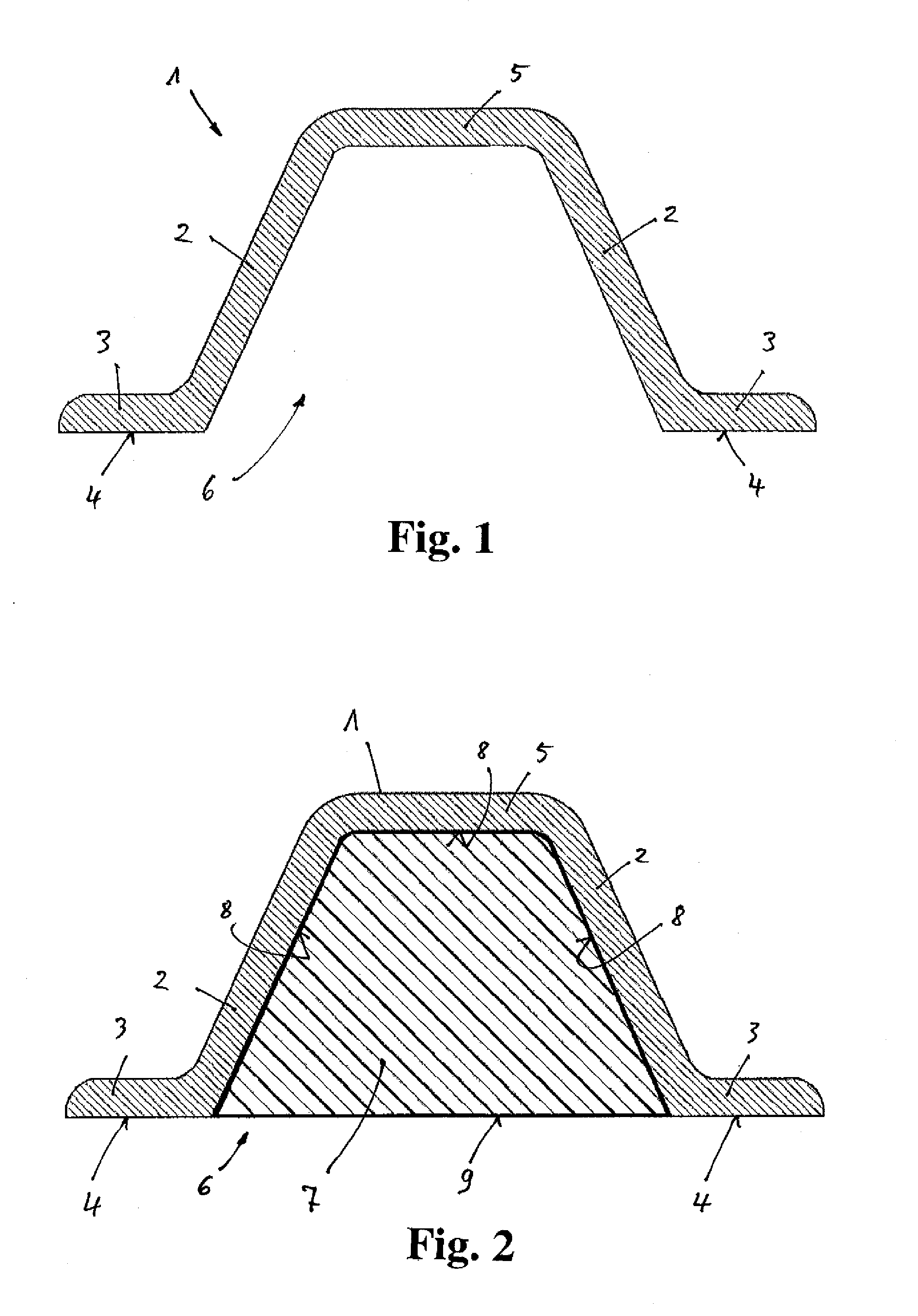Method for producing a fibre composite component for air and space technology
a composite component and air and space technology, applied in the direction of sustainable transportation, chemistry apparatus and processes, other domestic articles, etc., can solve the problems of poor adhesive bonding, poor component quality, porous laminates, etc., and achieve the effect of cost effectiv
- Summary
- Abstract
- Description
- Claims
- Application Information
AI Technical Summary
Benefits of technology
Problems solved by technology
Method used
Image
Examples
first embodiment
[0069]FIG. 1 is a schematic cross-sectional view of a reinforcing element 1. FIG. 2 shows the view according to FIG. 1 with a cross section of a mould core 7 according to the invention and FIG. 3 is a schematic perspective view of an embodiment of a fibre composite component 10 according to the invention during production according to a first method of the invention.
[0070]In this embodiment, the reinforcing element 1 is a so-called omega stringer with a kind of hat-shaped profile, as shown in FIG. 1, and it stands vertically on the plane of the drawing. A perspective view is provided in FIG. 3, where two reinforcing elements 1, for example, are illustrated which are attached for reinforcement purposes to a base component 11, for example a shell component or a fuselage skin of an aircraft and spacecraft (not shown).
[0071]The reinforcing element 1 (see FIG. 1) has two opposite webs 2 which run obliquely upwards towards one another and are joined together at their upper ends by a horiz...
second embodiment
[0083]FIG. 6 is a schematic cross-sectional view of the mould core 7 according to the invention with the reinforcing element 1 according to FIG. 1. In this embodiment, the mould core 7 is formed with a core inner space 18 which can be filled with a further core during production of the mould core 7. Due to its low weight, this type of mould core 7 is suited, for example to remaining in the reinforcing element 1, a possible core being removed from the core inner space 18.
[0084]In this case, the mould core 7 is used with a reinforcing layer 16 which is, for example, a tear-proof layer of woven fabric. However, it can also be a different reinforcing material, for example a tear-proof separating film. This reinforcing layer 16 can also be used instead of or as the separating layer 15 (see FIGS. 4 and 5). The reinforcing layer 16 is particularly advantageous when the mould core 7 is pulled out on removal from the mould, as it is protected from damage by said layer and its re-usability is...
third embodiment
[0085]FIG. 7 is a schematic, cross-sectional view of the mould core 7 according to the invention with the reinforcing element 1 of FIG. 1, and in this case, the mould core 7 is composed of three core segments 19. Here, the core segments 19 each have triangular cross sections, but are not restricted thereto.
[0086]The core segments 19 are rigidly joined, for example adhesively bonded to one another, the adhesive being suitable for the temperatures and pressures during production of the fibre composite component 10 and resistant to the matrix materials used. This embodiment is suitable for relatively large core cross sections, for example. The core segments 19 can be produced by simple core tools 14.
[0087]FIG. 8 is a schematic cross-sectional view of a fourth embodiment of the mould core 7 according to the invention with the reinforcing element 1 of FIG. 1. In this connection, FIG. 9 is a schematic plan view of a sheet material 20 for producing the mould core 7 of the fourth embodiment...
PUM
| Property | Measurement | Unit |
|---|---|---|
| Size | aaaaa | aaaaa |
Abstract
Description
Claims
Application Information
 Login to View More
Login to View More - R&D
- Intellectual Property
- Life Sciences
- Materials
- Tech Scout
- Unparalleled Data Quality
- Higher Quality Content
- 60% Fewer Hallucinations
Browse by: Latest US Patents, China's latest patents, Technical Efficacy Thesaurus, Application Domain, Technology Topic, Popular Technical Reports.
© 2025 PatSnap. All rights reserved.Legal|Privacy policy|Modern Slavery Act Transparency Statement|Sitemap|About US| Contact US: help@patsnap.com



